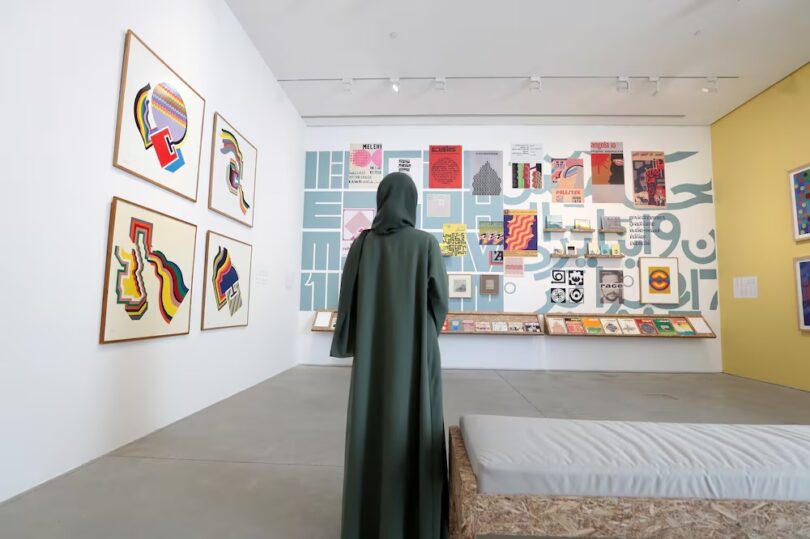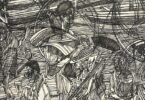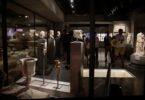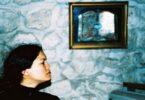Razmig Bedirian
Following Morocco’s independence from France in 1956, an artistic movement began in Casablanca that would become a pillar of cultural decolonisation in the wider Arab world. It was the bedrock of artistic tenets that many practitioners uphold today: to honour tradition and history while striving for the cutting edge.
The Casablanca Art School (CAS) was established by French colonial powers in the early 1920s. In the beginning, the school’s faculty and students were mostly French. Its curriculum, meanwhile, was based on western pedagogy, sidelining arts and crafts from the Maghreb region.
This changed after Morocco’s independence. The school also began a cultural revolution that kick-started a new way of thinking about artistic practices across the Middle East and North Africa. Now, an exhibition by Sharjah Art Foundation delves into the significance and impact of this movement, charting its development from 1962 and 1987.
The exhibition (The Casablanca Art School: Platforms and Patterns for a Postcolonial Avant-Garde) is running at the foundation’s Al Hamriyah Studios and Old Al Diwan Al Amiri until June 16. It is curated by Morad Montazami and Madeleine de Colnet, alongside Hoor Al Qasimi, director of Sharjah Art Foundation. It is organised by the foundation and Tate St Ives in collaboration with Schirn Kunsthalle Frankfurt.
Considered one of the first proper surveys of the school and its legacy, the exhibition first opened in 2023 at Tate St Ives, before travelling to Sharjah. It is segmented into sections either titled Platforms or Patterns. The former is dedicated to spotlighting important landmarks in the school’s timeline. Patterns, meanwhile, showcases motifs and artistic methodologies.

The exhibition begins with the story of CAS’s emergence as a creative hub for Moroccans. In 1962, artist Farid Belkahia returned to Morocco from Prague and, after becoming director of CAS, began to reform the school’s programme and mission. The school no longer became simply an institution where students attended classes. Instead, it became a collaborative artistic playground of sorts.
“What interested us as a foundation was the collective aspect of this school,” says May Alqaydi, assistant curator of the exhibition. “It was a movement. A community of artists that came together and gathered in this newly-independent country.”
Having studied and practised abroad, Belkahia had established a network of artists, including Moroccan creatives in the diaspora. He invited them to teach at the school. Notable figures included Mohammed Chabaa and Mohamed Melehi, who together with Belkahia would become informally known as the Casablanca Trio. Another important figure was Ahmed Cherkaoui, who was one of the pioneers of looking at Amazigh tattoos and symbols as artistic inspiration and through a modern lens.
“Belkahia wanted to change the way everything was taught in the school,” Alqaydi says.

The first space within the exhibition, aptly titled Platform 0: Beginnings, makes this clear from the onset. It features early works by some of the movement’s core figures. It also highlights the contributions of Toni Maraini, who concretized the school’s mission through essays and writings.
Platform 0: Beginnings also features works and materials from the school’s first major exhibition. It was held in 1966 at the Mohammed V National Theatre in Rabat. The fact that the exhibition was held in a somewhat public space was in itself subversive and signalled the artistic changes that would come to sweep across the country. It challenged the preceding salon exhibitions, organised by the state, that were the norm during the French colonial period, and which often diminished works produced by Moroccan artists.
“Up until that time, art exhibitions were just salons. They were very exclusive,” Alqaydi says. “Most of those exhibiting were French or Western artists. When they did show works by Moroccan artists, they were considered naive. That really was a triggering thing for the Casablanca group.”

The 1966 exhibition was a rallying cry. Moroccans were now taking control of their own artistic narrative.
In 1968, another seminal exhibition by the school was organised. This time, it was dedicated to the works of students and was held at the Arab League Park Pavilion in Casablanca. The exhibition in Sharjah delves into some of the works from the 1968 show and shows how the school had sharpened its focus and artistic intent in a few short years.
Some of those students are well known and celebrated today, including Malika Agueznay.
The school actively tried to diminish “the hierarchy between student and professor and make it more of dynamic, experimental space, where everyone is learning from everyone,” Alqaydi says.

Maraini outlined the school’s mission in its booklet. Her writing is referenced in the wall text in this section to help viewers appreciate the significance of the 1968 exhibition and how the students at CAS strove to not become artists working in vacuum, but to engage themselves with the changing social and cultural landscape of Morocco.
The school, Maraini wrote, aimed to instil “’the notion of anonymous and collective creation” – a methodology that was drawn from the country’s artistic traditions. Perhaps most importantly, the school stressed the importance to students of keeping their fingers on the pulse, that is to reflect “the reality of a country that is being built”. The artist had an important role to play in the country’s cultural, social and economic reform.
This role was emboldened with Presence Plastique – Plastic Presence. The 1969 exhibition was held outdoors, in the Jemaa el-Fna Square in Marrakesh and Casablanca’s 18 November Square. A video shot by Melehi, who besides his artistic output was also a steadfast documentarian of the school, offers a glimpse of these outdoor interventions, showing sprawling and vibrant artworks in the backdrop of bustling streets. It was a stride in CAS’s mission in bringing art to Morocco’s public.
“People were really inspired by these artworks,” Alqaydi says. “They did not just take over the streets in terms where they just put paintings out there. They also kind of started painting shops, painting facades.”
The works themselves spurred a new trend across Morocco, where shopfronts were decorated in ways that were inspired from the works of the CAS artists.
Alqaydi underscores that while there were core figures within the CAS group, the movement should be thought more of as “a constellation of artists”.

“They were not only students and professors, some of them did both,” she says. “Some of them really just came for a certain time, collaborated and influenced others. This is why we actually call them a constellation of artists and not just a group of artists because there is some sort of a core but then it was changing.”
With its Patterns sections, the exhibition starts exploring how the school found inspiration in traditional Moroccan art, including Amazigh patterns, found on rugs, jewellery and tattoos, as well as African, Islamic and Mediterranean designs.
The research conducted by Dutch anthropologist and tutor Bert Flint was a seminal resource for the students and faculty of the school alike. Flint researched the traditions, crafts and heritage of rural Morocco for decades, and there is a special section within the Old Al Diwan Al Amiri that highlights his contributions.

CAS students offered new twists to these crafts, which for a long time Western pedagogy classified as merely ornamental and utilitarian. The motifs became springboards to a new mode of abstraction.
The crafts also inspired artists to use local materials, including copper, wood and wool within their works. The traditions were revitalised in a contemporary realm and the motifs were no longer relegated to mere history.
The exhibition also delves into the printmaking and poster designs produced by the group, showing how their efforts were pan-Arab or even international. Chabaa is quoted within the Graphic Design section as saying “the poster is a painting that is accessible to all.”
The section features posters that were produced in solidarity with those in Palestine, Angola, Chile, as well as works that advertise exhibitions by CAS artists. There are also issues of the journal Souffles, designed by Chabaa and Melehi, which was dedicated to poetry, literature and cultural criticism.
The SAF exhibition also touches upon the legacy of the school by delineating how it branched several other projects. Chabaa’s Studio 400, for instance, was dedicated to for graphic and interior design.
Melehi, meanwhile, launched a publishing and graphic design studio named Shoof. Then there was the gallery L’Atelier, which showcased CAS artists as well as those from the wider region, promoting cross-cultural collaborations and exposure.
The exhibition trails off around the 1980s, but while touching upon how the legacy of CAS still thrives today.
“We’re really focusing on the 60s, 70s and 80s, and the shift that happened after the independence” Alqaydi says. “We’re focusing on the post colonial aspect of it, and their relation to modern art.
“Sometimes we say that the West influenced us, but in reality we have a lot of things in our culture, the Arab, Moroccan, pre-Islamic and Islamic culture that is very much modern and could be used as a contemporary inspiration. This is what the Casablanca School actually saw.”
Courtesy: thenationalnews







